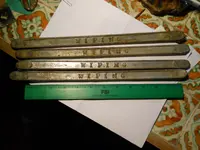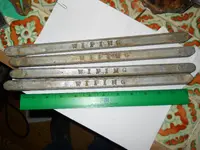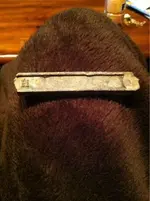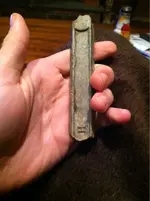You are using an out of date browser. It may not display this or other websites correctly.
You should upgrade or use an alternative browser.
You should upgrade or use an alternative browser.
Lead bar with an H
- Thread starter Ninjafossils
- Start date
Jason in Enid
Gold Member
- Joined
- Oct 10, 2009
- Messages
- 9,581
- Reaction score
- 9,205
- Golden Thread
- 0
- Primary Interest:
- All Treasure Hunting
Yep, a solid bar of lead solder used by plumbers and roofers and probably others in the past.
Upvote
0
Charlie P. (NY)
Gold Member
- Joined
- Feb 3, 2006
- Messages
- 13,021
- Reaction score
- 17,188
- Golden Thread
- 0
- Detector(s) used
- Minelab Musketeer Advantage Pro w/8" & 10" DD coils/Fisher F75se(Upgraded to LTD2) w/11" DD, 6.5" concentric & 9.5" NEL Sharpshooter DD coils/Sunray FX-1 Probe & F-Point/Black Widows/Rattler headphone
- Primary Interest:
- Metal Detecting
No unit cast their own Minie balls in the Civil War - North or South.
Looks like bar solder to me.
Looks like bar solder to me.
Upvote
0
BosnMate
Gold Member
- Joined
- Sep 10, 2010
- Messages
- 6,916
- Reaction score
- 8,441
- Golden Thread
- 0
- Detector(s) used
- Whites MXT, Whites DFX, Whites 6000 Di Pro
- Primary Interest:
- Other
Can you scratch it with your thumb nail. If it scratches, odds are it's pure lead and possibly intended for bullets, pre Civil War. If it doesn't scratch, then it's probably solder or tin, used for news print, tire weights, modern bullets, plumbing etc.
Upvote
0
gunsil
Silver Member
- Joined
- Dec 27, 2012
- Messages
- 3,863
- Reaction score
- 6,207
- Golden Thread
- 0
- Location
- lower hudson valley, N.Y.
- Detector(s) used
- safari, ATPro, infinium, old Garrett BFO, Excal, Nox 800
- Primary Interest:
- All Treasure Hunting
It isn't for bullets, it isn't pre civil war or civil war era. You CAN scratch solder, tire weights, printer's lead, etc with your finger nail. It is a lead alloy for doing body work before the advent of modern "plastic" "bondo" fillers. It was used quite recently still on large truck body work because it adheres better than the "bondo" fillers and the trucks vibrate more than cars. I have a bunch of those bars from an old body shop and have watched body repairmen use it.
Upvote
0
BosnMate
Gold Member
- Joined
- Sep 10, 2010
- Messages
- 6,916
- Reaction score
- 8,441
- Golden Thread
- 0
- Detector(s) used
- Whites MXT, Whites DFX, Whites 6000 Di Pro
- Primary Interest:
- Other
It isn't for bullets, it isn't pre civil war or civil war era. You CAN scratch solder, tire weights, printer's lead, etc with your finger nail. It is a lead alloy for doing body work before the advent of modern "plastic" "bondo" fillers. It was used quite recently still on large truck body work because it adheres better than the "bondo" fillers and the trucks vibrate more than cars. I have a bunch of those bars from an old body shop and have watched body repairmen use it.
Sorry Gunsil, but if you can scratch grooves with you thumb nail in news print, wheel weights etc. then you are a better man than I am. My test for pure lead for casting round balls for my muzzleloaders is to scratch it with my thumb nail. No groove, I use it for other things that require harder lead, like bullets for my 45-70. It's not a big deal, I'm not going to do a lot of research because I want to prove something. I know what it is, because I do it, and if it scratches a groove with a thumbnail, it aint being used to replace bondo.
Upvote
0
gunsil
Silver Member
- Joined
- Dec 27, 2012
- Messages
- 3,863
- Reaction score
- 6,207
- Golden Thread
- 0
- Location
- lower hudson valley, N.Y.
- Detector(s) used
- safari, ATPro, infinium, old Garrett BFO, Excal, Nox 800
- Primary Interest:
- All Treasure Hunting
Sorry Gunsil, but if you can scratch grooves with you thumb nail in news print, wheel weights etc. then you are a better man than I am. My test for pure lead for casting round balls for my muzzleloaders is to scratch it with my thumb nail. No groove, I use it for other things that require harder lead, like bullets for my 45-70. It's not a big deal, I'm not going to do a lot of research because I want to prove something. I know what it is, because I do it, and if it scratches a groove with a thumbnail, it aint being used to replace bondo.
Not used to replace Bondo, mostly used before bondo. All you doubters just need to find a 70-80 year old body repairman and ask him what they used before bondo. It was called "leading" when they filled minor dents with the lead alloy. It is almost a lost art, but it is still used in high-end restoration shops. Porsche used it in the factory to ensure that all seams were perfect on their 356 model cars, and some of their later models. I was a mechanic for forty some years, and used wheel weights every day and many can easily be scratched with my thumb nail. Today they are trying to do away with lead in wheel weights, and are using other alloys. I have cast thousand and thousands of muzzle loader rounds myself and am familiar with many of the lead alloys. Many wheel weights contain antimony which isn't good for bores, even in your 45-70.
Kuger, please do show us lead bars that were used for casting bullets before the civil war!! Especially those that look similar to the OP's bar. I'd like to see any others too.
Upvote
0
Jason in Enid
Gold Member
- Joined
- Oct 10, 2009
- Messages
- 9,581
- Reaction score
- 9,205
- Golden Thread
- 0
- Primary Interest:
- All Treasure Hunting
Not used to replace Bondo, mostly used before bondo. All you doubters just need to find a 70-80 year old body repairman and ask him what they used before bondo. It was called "leading" when they filled minor dents with the lead alloy.
It's where the term "lead sled" comes from for highly customized cars. They did so much cutting and re-shaping and all the seems were leaded. They said the cars were more lead than steel, hence "lead sled".
Upvote
0
gunsil
Silver Member
- Joined
- Dec 27, 2012
- Messages
- 3,863
- Reaction score
- 6,207
- Golden Thread
- 0
- Location
- lower hudson valley, N.Y.
- Detector(s) used
- safari, ATPro, infinium, old Garrett BFO, Excal, Nox 800
- Primary Interest:
- All Treasure Hunting


Here's some bars of body shop "lead" bars for auto body repair. As you can see they are just like the OP's bar except for the writing. These say "wiping" because they came in slightly different alloys for different uses in body repair. Wiping was the final process before sanding smooth and priming for paint. Some don't have the usage on them but instead have a manufacturer's name or initials or logo. I can lightly gouge them with my thumb nail and they are not pure lead, they are a lead/tin alloy.
Kuger, come on and show us your pre-civil war lead bars for casting bullets!!
Upvote
0
tennessee digger
Bronze Member
Charlie P. You stated that no unit cast their own minie balls during the civil war. Not trying to be a "know it all" but you are wrong. I've dug several bullet molds in camps, found countless pounds of slag lead and dug many mis-molded bullets over the years. They did, indeed, cast their own bullets on occasion. Granted, most were pre packed and made in factories.
Upvote
0
TheCannonballGuy
Gold Member
- Joined
- Feb 24, 2006
- Messages
- 6,606
- Reaction score
- 13,450
- Golden Thread
- 0
- Location
- Occupied CSA (Richmond VA)
- Detector(s) used
- White's 6000, Nautilus DMC-1, Minelab
- Primary Interest:
- Relic Hunting
Charlie P wrote:
> No unit cast their own Minie balls in the Civil War - North or South.
Guys, I'm just speaking up to prevent some people from misunderstanding Charlie P.'s statement. (Please read its exact wording.) He is correct that no UNIT (regiment) cast their own MINIE-BALLS in the civil war. If the army issued you a firearm, the army also provided the ammunition for it. However, some civil war soldiers (particularly, the early-war Volunteer soldiers rather than the Draftees) bought firearms for themselves. Therefore, they had to provide their own ammunition. That is why so many variations of bulletmolds (and some small lead bars) have been dug from civil war battlesites and encampments.
Back in the mid-1970s, I myself found a bullet-casting spot in a ravine right behind a Confederate entrenchment at the Kennesaw Mountain (Georgia) battlefield. In a 10-foot circular area, among a large number of lead-driplets, me and my mid-1970s digging-buddy John Sexton dug about a dozen Colt Revolver bullets which had been discarded because they were imperfectly-cast. Along with lots of lead-driplets, we found a very short piece of small lead bar.
Repeating, for absolute clarity... if you were a civil war soldier who brought your own privately-purchased (non-Army-issued) firearm into service, you were responsible for providing the bullets for it. Gun-dealers typically sold the appropriate bulletmold along with the firearm so the buyer could make bullets for it.
> No unit cast their own Minie balls in the Civil War - North or South.
Guys, I'm just speaking up to prevent some people from misunderstanding Charlie P.'s statement. (Please read its exact wording.) He is correct that no UNIT (regiment) cast their own MINIE-BALLS in the civil war. If the army issued you a firearm, the army also provided the ammunition for it. However, some civil war soldiers (particularly, the early-war Volunteer soldiers rather than the Draftees) bought firearms for themselves. Therefore, they had to provide their own ammunition. That is why so many variations of bulletmolds (and some small lead bars) have been dug from civil war battlesites and encampments.
Back in the mid-1970s, I myself found a bullet-casting spot in a ravine right behind a Confederate entrenchment at the Kennesaw Mountain (Georgia) battlefield. In a 10-foot circular area, among a large number of lead-driplets, me and my mid-1970s digging-buddy John Sexton dug about a dozen Colt Revolver bullets which had been discarded because they were imperfectly-cast. Along with lots of lead-driplets, we found a very short piece of small lead bar.
Repeating, for absolute clarity... if you were a civil war soldier who brought your own privately-purchased (non-Army-issued) firearm into service, you were responsible for providing the bullets for it. Gun-dealers typically sold the appropriate bulletmold along with the firearm so the buyer could make bullets for it.
Upvote
0
gunsil
Silver Member
- Joined
- Dec 27, 2012
- Messages
- 3,863
- Reaction score
- 6,207
- Golden Thread
- 0
- Location
- lower hudson valley, N.Y.
- Detector(s) used
- safari, ATPro, infinium, old Garrett BFO, Excal, Nox 800
- Primary Interest:
- All Treasure Hunting
View attachment 923161Gunsil,your barking up the wrong tree if you want a fight.....I will do ya one better,just dug one .If I went out and unpacked box's I could show ya many more,too.Surely you arent doubting there existence?How do you think lead came to cast bullets?As said,go some where else if you want a fight,I am not interested
several C.W. period Bars listed here
Sgt Riker's Civil War Trading Post - Camp Items
Here........few items of the subject from start to finish....all from Pre-C.W. sites!!!!As said,if I was to go looking through box's,I have many more bars.....not uncommon,were a necessity!View attachment 923149View attachment 923149
Gee whillikers!! Don't get your knickers in a knot!! I had to go out and dig out my body shop lead bars, no biggie. I like seeing your old lead, but the OP's piece still looks more like my body shop bars. Some of those pieces in your pile don't exhibit the white patina of really old lead and may not be as old as you think. And like Cannon Ball said, only soldiers with their own, not government supplied guns needed to make bullets, it was not really a common practice. Even in the Revolutionary war most ball casting was done in homes, churches, forts, etc., little was done in the field. Not trying to fight, just trying to get a realistic ID on the OP's item.
Upvote
0
taz42o
Bronze Member
Im posting this because its interesting ,not to argue ID because you cant get a definite ID without a makers name or knowing the alloy. It could be any of the suggestion made so far.
Someone here found one that was IDed with makers name.
http://www.treasurenet.com/forums/today-s-finds/88414-civil-war-lead-casting-bar-bullets.html
Lead Ingot - Odyssey's Virtual Museum
North American Frontiersmen
Someone here found one that was IDed with makers name.
http://www.treasurenet.com/forums/today-s-finds/88414-civil-war-lead-casting-bar-bullets.html
Lead Ingot - Odyssey's Virtual Museum
North American Frontiersmen
Upvote
0
Ninjafossils
Hero Member
- #16
Thread Owner
Wow. Guys this is getting out of hand. All I wanted to know was what this lead was used for. This name calling and other bs is childish. Quite acting like Children or don't continue posting
Upvote
0
Similar threads
- Question
- Replies
- 7
- Views
- 469
Users who are viewing this thread
Total: 1 (members: 0, guests: 1)






